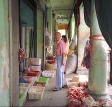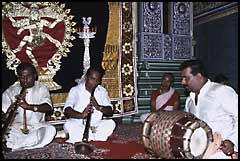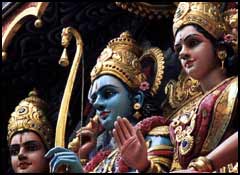 |
 |
 |
 |
| Chinatown |
| Stamford Raffles |
| Unique Food |
Singapore's "Little
India" area is about as un-Singaporean as can be.  The
city's old Chinatown district has largely been obliterated by towering, sleek,
office high-rises, and the traditional Muslim area around Arab Street lingers
in an advanced, if not unpleasant, state of somnambulism. But Serangoon, or
"Lit
The
city's old Chinatown district has largely been obliterated by towering, sleek,
office high-rises, and the traditional Muslim area around Arab Street lingers
in an advanced, if not unpleasant, state of somnambulism. But Serangoon, or
"Lit tle
India", is fabulously lively, bustling and buoyant - a tourist's dream
come true. Today, it stands out in Singapore like a sore thumb, but a very welcome
one indeed. Predictably, tourists flock to the area in droves.
tle
India", is fabulously lively, bustling and buoyant - a tourist's dream
come true. Today, it stands out in Singapore like a sore thumb, but a very welcome
one indeed. Predictably, tourists flock to the area in droves.
Being well aware of the pulling power of "Little India", the authorities
are currently giving it a face-lift, so as to make it visually even more appealing.
The project is partly spurred by the successful restoration of the Tanjong Pagar
area, in which more than 200 old Chinese houses were painstakingly renovated,
creating a magnificently colourful sight.
"Little India" stretches along the southern
end of Serangoon Road, some 800 metres lined with Indian shops and restaurants.
You can buy anything Indian here, just like in any Indian bazaar street - the
choicest silk sarees, elaborate Indian gold jewellery, aromatic incense sticks,
Indian curios and furniture, the latest music hits in Hindi or Tamil, freshly
ground spices and posters depicting your favourite Hindu film star. Women from
Madras proffer Indian mangoes and various Indian knick-knacks, laid out on the
pavement. The restaurants in the area offer all the well-known South Indian
dishes, such as Masala Dosa (a kind of pancake with spicy vegetarian filling),
Idli (steamed rice cakes) or as-much-as-you-can-eat meals, served on environment-friendly
banana leaves. If in doubt about your future, you may consult an Indian soothsayer
and his tireless little parrot - the latter will expertly pick out your prediction
from a pack of cards. Don't worry, to keep the customer satisfied, the predictions
tend to be very much on the positive side. All things said, "Little India"
comes across as a cleaner, more wholesome version of Madurai or Madras.

"Little India", and Singapore for that matter, have come a long way since Stamford Raffles set foot on the island for the first time in 1819. Stamford Raffles (1781-1824), then Lieutenant-General of Bencoolen, Java, had been ordered by Lord Hastings to found a commercial outpost for the East India Company in the region of the Malay Peninsula; Raffles' choice fell on Singapore, which means "Lion City" in Sanskrit. Until then, the island had been home to a handful of sea nomads and pirates. Pirate activity was so fierce, that, when Raffles stepped ashore for the first time, he saw "hundreds of human skulls" on the beach, "some still fresh with hair, others still with sharp teeth". According to local lore, even jinni and devils were afraid to visit the island.
But Raffles, convinced of Singapore's prime location, was not to be put off.
He negotiated with the ruling Sultan of Johore and finally bought Singapore
from him - for 80,000 Spanish Dollars and a yearly royalty of 20,000 Spanish
Dollars. The investment was soon to be recouped.
Under Raffles' administration, commerce flourished and
thousands of immigrants from all over Asia flocked to Singapore, among them
many Indians. In fact, the very first Indian to reach Singapore had been one
Narayana Pillai, who had accompanied Raffles on his first-time visit to the
island. Pillai, quite a shrewd businessman himself, soon built Singapore's first
brick kiln - in the area of today's "Little India". Chinese immigrants,
for their part, drained the swampy marshland of Serangoon and established fruit,
vegetable and betel gardens. Indians soon used the area to graze cattle; thus
you still find a Buffalo Road in "Little India", as well as a Kerbau
Road, kerbau being Malay for buffalo.
The number of immigrants from India grew steadily, supplemented by numerous
Indian convicts, unceremoniously shipped over by the British. In the 1850's,
the first Hindu temples were built (partly using convict labour), rows of shophouses
were to follow. The current shophouses in "Little India" hail from
the 1920's. Indians today make up 7.2% of Singapore's population of 3 million.
To appreciate "Little India" to its fullest, start your visit at its
southern end, at the Little India Arcade. This block of shophouses has recently
been neatly renovated; it comprises Indian bric-a-brac stalls, curio and sweet
shops, as well as an inexpensive food centre. As you wind your way northwards
through Serangoon Road, a two minute walk brings you to the typically South
Indian Veerama Kaliammam Temple. Its intricate gopuram, or temple tower, is
adorned with countless figures of deities. The best time to visit the temple
is 6 p.m., when pooja or prayer rituals, are held, accompanied by frenzied drumming
and the wailing of the shahnai (a clarinet-like instrument). Just a hundred
metres behind this temple, you find another one - the North Indian style Lakshmi
Narayan Temple. On many evenings, colourful marriage functions are held here,
and nobody minds if you just come in and watch.
Walking further up Serangoon Road, you first pass countless little Indian shops
and restaurants, then the somewhat austere Angullia Mosque. Just across the
road, where Syed Alwi Road meets Serangoon Road, you find a veritable Serangoon
institution - Mohamed Mustafa's department store, located within the precincts
of Serangoon Plaza. This is a no frills, rock-bottom priced department store,
named after its owner. Mohamed Mustafa is a real-life legend in "Little
India": In his younger days, he had only a little convenience shop in Serangoon
Road. Having made a bit of money, he invested it in a new shop in Serangoon
Plaza - and made it BIG. Customers, especially from the Indian Subcontinent,
were attracted to the shop like bees to honey. Mohamed Mustafa became a household
name and the tills kept ringing. In April 1995, he opened another, much bigger
department store just around the corner in Syed Alwi Road, Mustafa Centre. You
can buy virtually anything here, at the lowest prices in town - from electronics
to clothes, from Indian herbal cosmetics to mango pickles.
Mohamed Mustafa is in his fifties now and has been dubbed "The Raja of
Little India" by the local press. His assets are said to be worth over
in the region of US$100 million. Despite this, he has remained a singularly
modest and humble man.
The only real danger lurking in "Little India" are the hordes of Chinese
trishaw men, mental descendants of Genghis Khan, who recklessly cart around
groups of Far Eastern tourists. In the process, they break every traffic rule
known to man since a troglodyte rolled the first stone wheel out of his cave.
When you see them coming, better step aside. Well aware of this nuisance, the
authorities have already considered a complete ban on the trishaws.
In line with Serangoon's growing popularity, a number of budget hotels have
recently been opened in the area. Keep in mind, though, that "budget",
in the Singaporean sense of the word, means US$50-100 per day. There are a few
guest houses in the US$20-30 bracket, but you wouldn't want to celebrate your
honeymoon there. Most of the cheapies have no licence and thus don't display
any signboards. Ask around in the lanes around Angullia Mosque, or at the Indian
restaurants in Upper Dickson Road and Race Course Road. Some of the restaurants
have guest rooms on top.
One of the swankier new entrants in the hospitality trade is the pleasant Fortuna
Hotel opposite Serangoon Plaza. If you happen to believe in ghosts though, this
may not be your kind of place: on this very spot in 1986, an old Chinese hotel
collapsed, killing over thirty people. The incident rates as one of Singapore's
worst ever disasters, and some superstitious locals may give the hotel a wide
berth. This writer, having visited the hotel's excellent Indian restaurant on
several occasions, deems it pretty much ghost-free.
Speaking of food, one of Singapore's culinary specialities is Fish
Head Curry, served in several restaurants in "Little India". The meal
consists of rice, some curried vegetables and an oversized fish head swimming
in a spicy sauce. The best-known fish head establishment is the Apolo Banana
Leaf Restaurant in Race Course Road.
For more regular South Indian fare, try the highly popular and very reasonable
Gandhi Eating House in Chander Road, or New Madras Woodlands in Upper Dickson
Road. Among the best North Indian restaurants are the Tandoori in Serangoon
Plaza and Nur Jahan on Race Course Road. Don't be put off by the latter's unimaginative
interior - the food is superb. Their Paneer Bhurji (Indian cheese in a spicy,
creamy sauce) is absolutely addictive.
If there is any one time to "Little India", it's Sunday evenings.
From 6 p.m. onwards, thousands of construction workers from Southern India,
Sri Lanka and Bangladesh congregate in the area, melting into one teeming, chattering
mass of humanity. Every square inch of road is occupied, and you will have difficulties
advancing through the crowds. On the other hand, if you're keen to know what
overpopulation feels like, this is the time and the place.
Come midnight, and Serangoon's roads will be eerily quiet. As you walk back
to your hotel, the smell of spices and subdued sub-continental conversation
may make you feel you're in Madras. But no - it's just another night in "Little
India".
| Home | - | Chinatown | - | Little India | - | Local Food | - | Contact us | - |